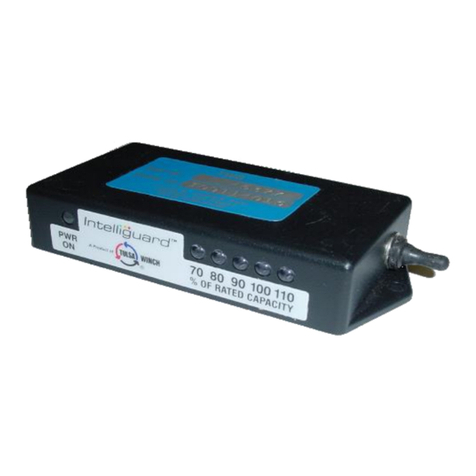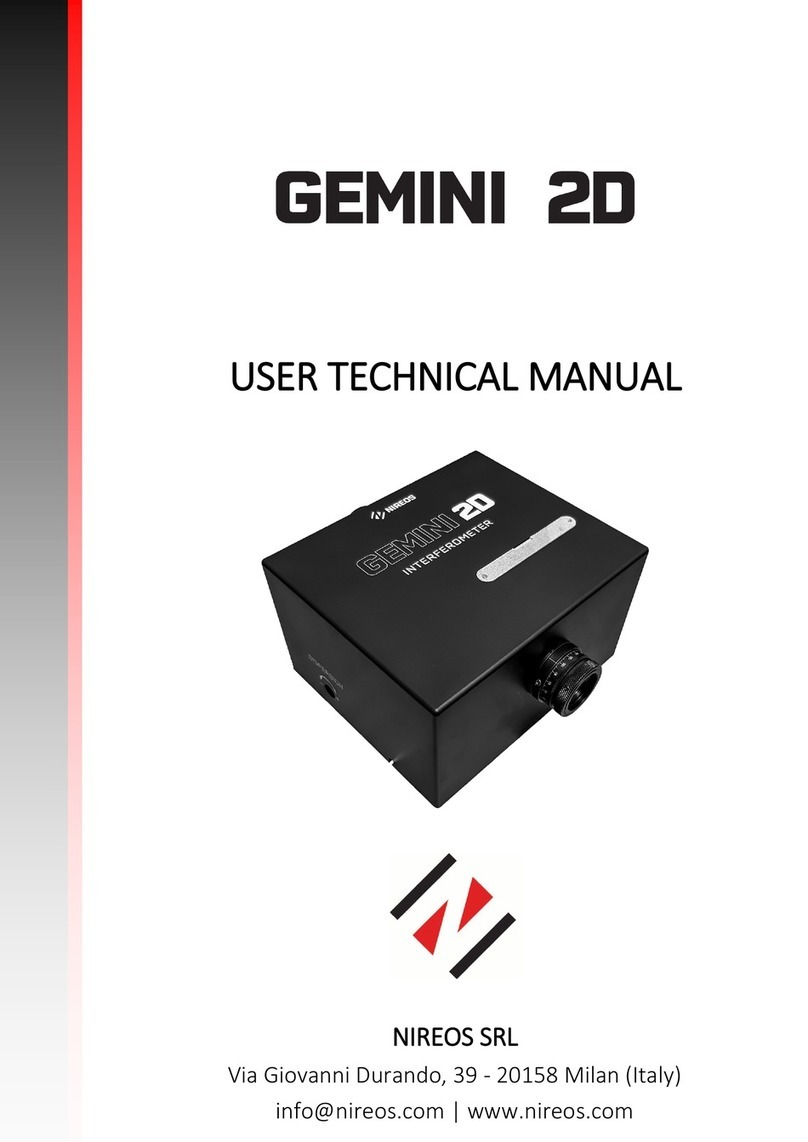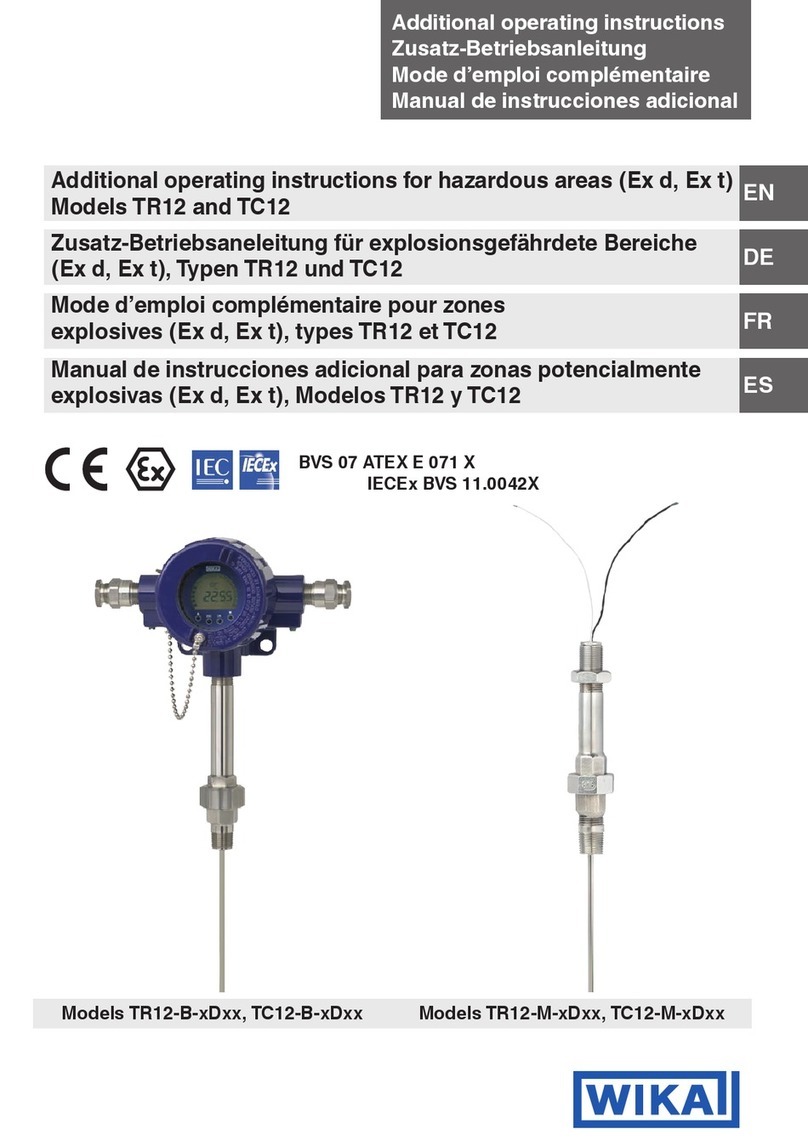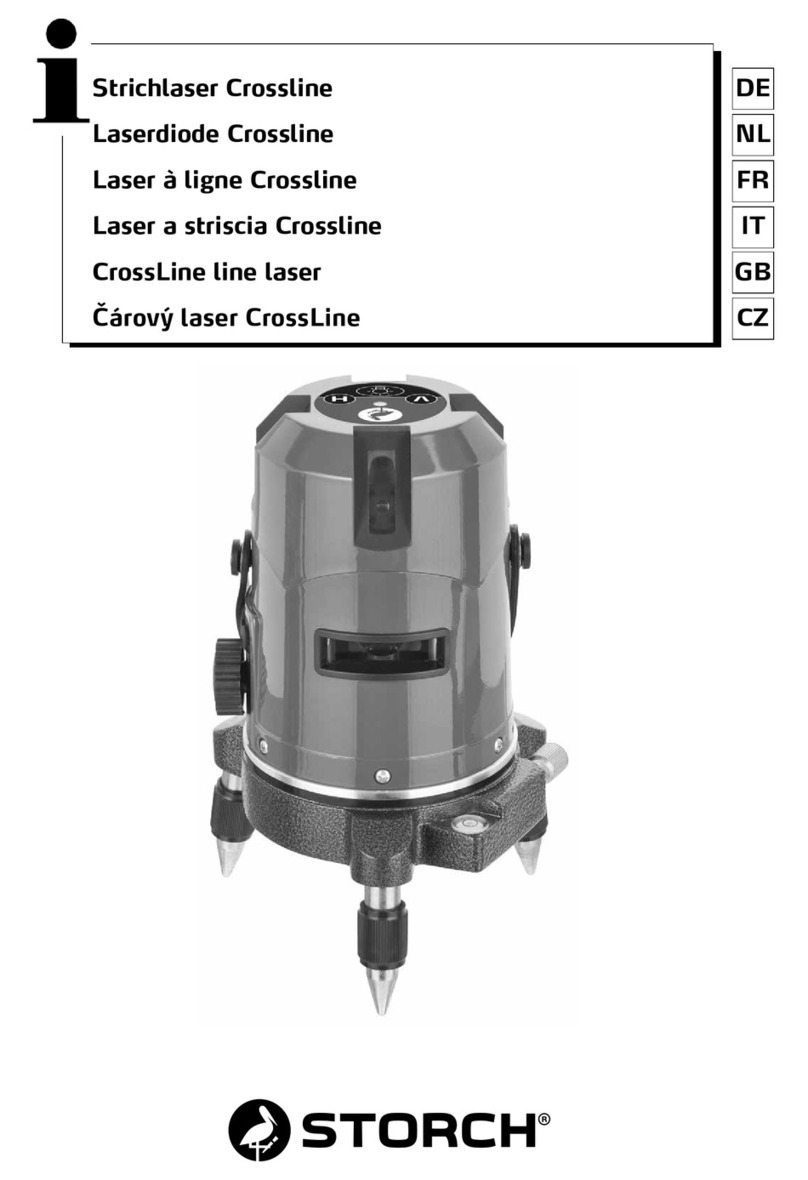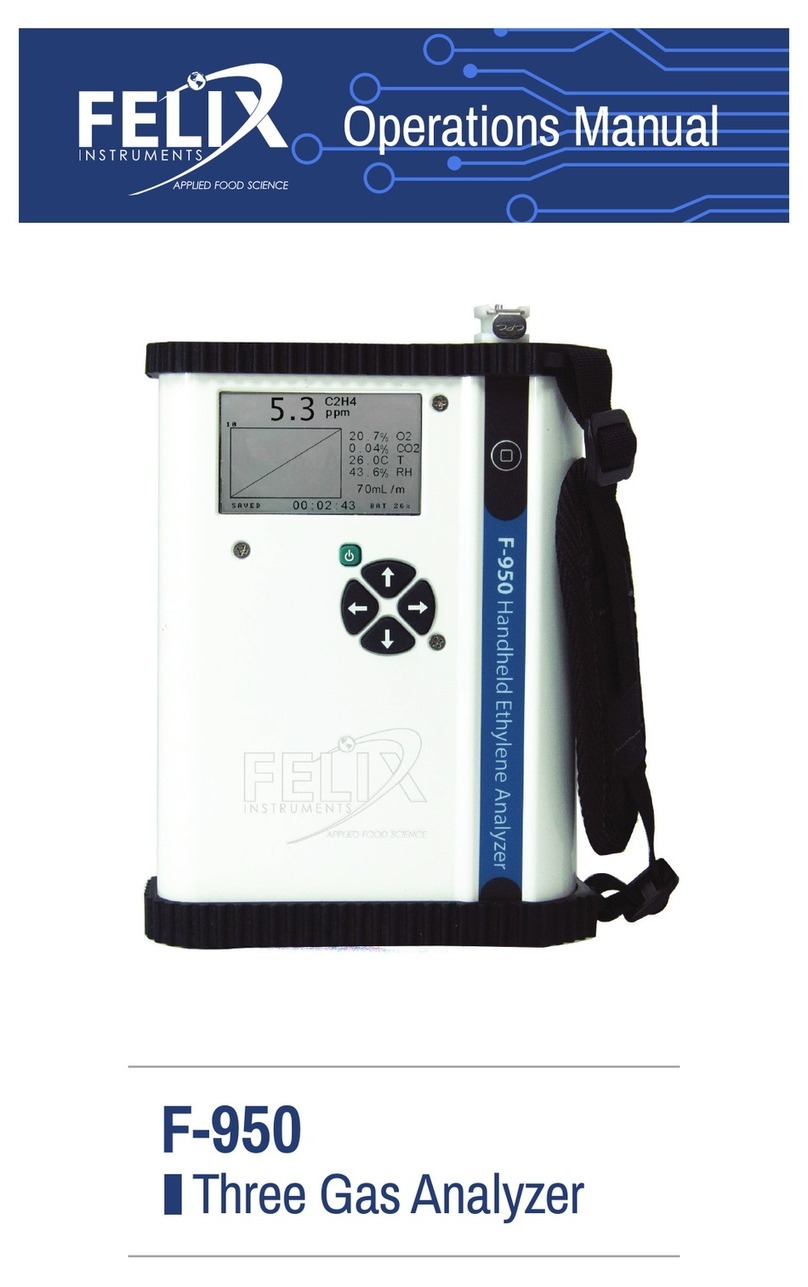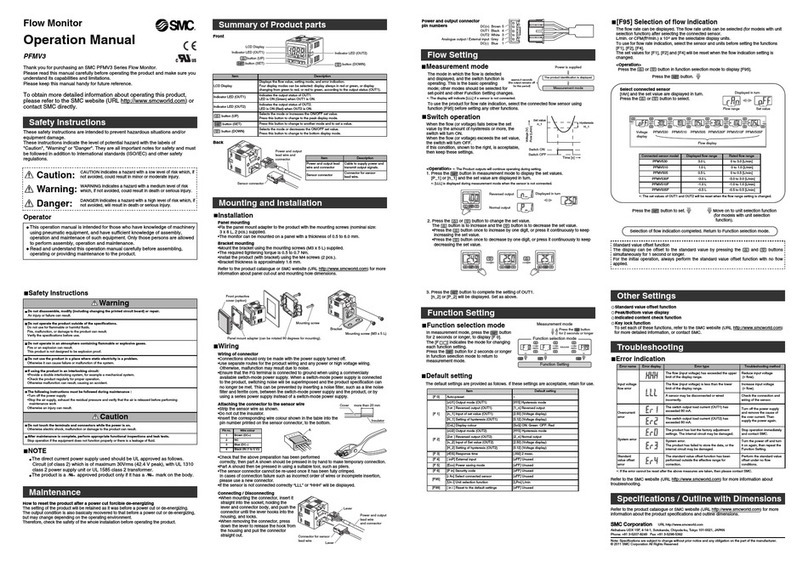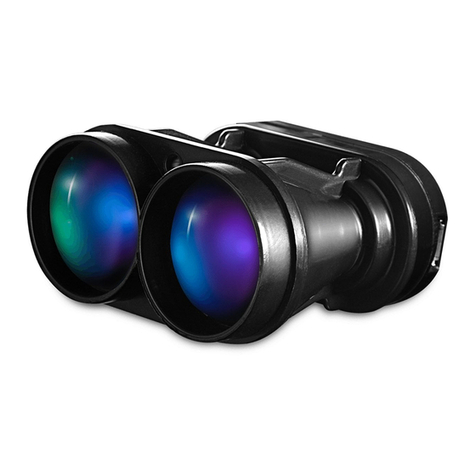Armstrong Monitoring AMC-1040 User manual

1040
Gas Monitor
INSTALLATION AND
OPERATING INSTRUCTIONS
AMC-1040 WITH INTEGRAL
ELECTROCHEMICAL SENSOR
IMPORTANT:
Please read these installation and operating instructions completely
and carefully before starting.
filename: Manual_amc1040ULapprove.doc
Revised, 8/7/2002
Copyright ©, May 2002, AMC
The Armstrong Monitoring Corporation
215 Colonnade Road South, Nepean, Ontario, Canada K2E 7K3
Tel: (613) 225-9531 • Fax: (613) 225-6965 • U.S. & Canada Toll Free: (800) 465-5777
E-mail: gas@armstrongmonitoring.com • Internet: www.armstrongmonitoring.com/gas/


AMC-1040 Monitor
i
TABLE OF CONTENTS
Section Title Page
1WARRANTY....................................................................................................................... ii
1.1 LIABILITY .....................................................................................................................ii
1.2 MODIFICATIONS AND SUBSTITUTIONS.................................................................... ii
1.3 PRODUCT RETURN ....................................................................................................ii
2PRODUCT INFORMATION ............................................................................................... iii
3PRODUCT DESCRIPTION................................................................................................. 1
4INSTALLATION.................................................................................................................. 4
4.1 LOCATION AND MOUNTING...................................................................................... 4
4.2 WIRING OF THE MONITOR........................................................................................ 4
5OPERATION AND CALIBRATION..................................................................................... 7
5.1 OPERATION................................................................................................................ 7
5.2 CALIBRATION............................................................................................................. 7
5.2.1 EQUIPMENT REQUIRED ........................................................................................ 7
5.2.2 ADJUSTMENTS....................................................................................................... 7
5.2.3 ALARM ADJUSTMENTS.......................................................................................... 8
6PREVENTIVE MAINTENANCE .........................................................................................11
6.1 GENERAL ..................................................................................................................11
6.2 SENSOR REPLACEMENT .........................................................................................11

AMC-1040 Monitor
ii
1 WARRANTY
The AMC-1040 monitor is warranted against defects in material and workmanship for a period
of two years from date of delivery, for sensor element warranty see page iv. During the warranty
period, we will repair or replace components that prove to be defective in the opinion of The
Armstrong Monitoring Corporation. We are not liable for auxiliary interfaced equipment, nor
consequential damage. This warranty shall not apply to any product which has been modified in
any way, which has been repaired by any other party other than a qualified technician or
authorized AMC representative, or when such failure is due to misuse or conditions of use.
1.1 LIABILITY
All AMC products must be installed and maintained according to instructions. Only qualified
technicians should install and maintain the equipment.
AMC shall have no liability arising from auxiliary interfaced equipment, for consequential
damage, or the installation and operation of this equipment. AMC shall have no liability for
labour or freight costs, or any other costs or charges in excess of the amount of the invoice for
the products.
THIS WARRANTY IS IN LIEU OF ALL OTHER WARRANTIES, EXPRESSED OR IMPLIED,
AND SPECIFICALLY THE WARRANTIES OF MERCHANTABILITY AND FITNESS FOR A
PARTICULAR PURPOSE. THERE ARE NO WARRANTIES THAT EXTEND BEYOND THE
DESCRIPTION ON THE FACE THEREOF.
1.2 MODIFICATIONS AND SUBSTITUTIONS
Due to an ongoing development program, AMC reserves the right to substitute components and
change specifications at any time without incurring any obligations.
1.3 PRODUCT RETURN
All products returned for warranty service will be by prepaid freight and they will only be
accepted with a repair number issued by AMC. All products returned to the client will be freight
collect.

AMC-1040 Monitor
iii
2 PRODUCT INFORMATION
Monitor Part Number ……………………………………
Monitor Serial Number ………………..…………………
Power Supply Requirements …………………………… 120 VAC, 60 Hz, 20 W max.
Operating Temperature Range …………………………
Relative Humidity ………………………………………...
Analog Output …………………………………………… 4-20 mA 250 ohms load max.
Contact Rating ……………………………………………
1/3 hp @ 120 VAC/240 VAC, 10 Amps
@ 28 VDC/120 VDC/240 VAC
Sensor Warranty …………………………………………
Sensor Life ………………………………………………..
SENSOR
Part No. Serial No. Gas/Range Low Alarm
Trip Point
High Alarm
Trip Point
TORQUE SPECIFICATIONS:
POWER SUPPLY:
Neutral terminal screw ……………………………………………………………… 7 pound-inches.
Hot terminal screw …………………………………………………………...……... 7 pound-inches.
Ground Lug screw ………………………………………………………….………. 15 pound-inches.
RELAY:
Relay socket terminal screws ……………………………………………………… 7 pound-inches.
Note:
All Armstrong Monitoring systems must be installed and maintained according to
instructions, to ensure proper operation. Only qualified technicians should install and
maintain the equipment.

AMC-1040 Monitor
1
3 PRODUCT DESCRIPTION
The AMC-1040 is an all in one gas monitoring system incorporating a highly specific
electrochemical sensor from AMC’s broad selection of available types. It serves to continuously
monitor the target gas (listed in Product Information Section). The monitor comes with the
following features (see Figures 1, 2 and 3).
1. POWER ON INDICATOR: Power is indicated by a green LED.
2. FAIL INDICATOR: Sensor fail is indicated by an amber LED.
3. LOW ALARM INDICATOR: Low levels of gas are indicated by a yellow LED.
4. HIGH ALARM INDICATOR: High levels of gas are indicated by a red LED.
5. POWER TERMINAL BLOCK: For line voltage connections (120 VAC, 60 Hz.)
6. TEST SWITCH: The test switch is provided to electronically simulate alarms
in order to test the low and high alarm indicators and relays.
7. LOW ALARM ADJUST: Sets the Low alarm trip point.
8. HIGH ALARM ADJUST: Sets the High alarm trip point.
9. THREE CIRCUIT MINIATURE
SWITCH:
Each actuator on the miniature switch controls a different
circuit as shown in Figure 1. If the actuator is set in the UP
position, its corresponding circuit is ON. If the actuator is
set in the DOWN position, the circuit is OFF.
9. a) TOP ACTUATOR: Provides a TEN minute time delay, when the switch is ON,
to eliminate unnecessary alarms caused by momentary
exposure to high alarm conditions.
9. b) MIDDLE ACTUATOR: Provides a FIVE minute time delay, when the switch is ON,
to eliminate unnecessary alarms caused by momentary
exposure to low alarm conditions.
9. c) BOTTOM ACTUATOR: Controls the audio alarm indicator. When ON, the buzzer
will activate when a high alarm condition occurs.
10. RELAYS:
There are up to 3 DPDT relays which work with high alarm,
low alarm, and as an option fail.
11. TRANSFORMER:
Class II, step down transformer runs the internal circuitry at
low voltages.
12. AUDIO ALARM: When enabled, the buzzer will activate when a high alarm
condition occurs.
13. ANALOG OUTPUT: 4-20 mA output 250 ohms load maximum.
14. ON-BOARD SENSOR: Allows local detection of gas.

AMC-1040 Monitor
2
HI
LOW
TIME DELAYS
ON
THREE CIRCUIT
MINIATURE SWITCH
AUDIO ALARM
ACTUATORS
Figure 1: Three-circuit miniature switch.
Figure 2: AMC-1040 monitor, front panel.

AMC-1040 Monitor
3
TB3
-IOUT+
4-20 mA
OUTPUT
-FAIL+
BUZZER
TB6
TB2
11
HIGH
LOW
FAIL
POWER
AUD
DLY
L
H
-LO+
-HI+
EC
ZERO
EC
SPAN
GND AC AC
11.
GND
NEUT. HOT
120 VAC
FUSE 1 A
SENSOR
10.
5.
8.
7.
9.
14.
13.
6.
HI
LOW
OPTIONAL
FAIL
12.
5. POWER TERMINAL BLOCK
6. TEST SWITCH
7. LOW ALARM ADJUST
8. HIGH ALARM ADJUST
9. THREE CIRCUIT MINIATURE SWITCH
10. RELAYS
11. TRANSFORMER
12. AUDIO ALARM
13. ANALOG OUTPUT
14. ON-BOARD SENSOR
Figure 3: AMC-1040 monitor, internal wiring.

AMC-1040 Monitor
4
4 INSTALLATION
4.1 LOCATION AND MOUNTING
Care should be taken to securely fasten the AMC-1040 monitor unit (via four mounting holes
provided) to a solid, vertical, non-vibrating surface or structure. Mounting height is dependent on
gas type. (See Figure 4 for mounting dimensions.)
Note:
All cable entry MUST be through the BOTTOM of the monitor enclosure only. Other
entry locations will allow foreign materials to enter the enclosure, possibly causing
damage to internal components. Mounting hardware and conduit connections are NOT
supplied.
Mount the 1040 monitor in a NON-HAZARDOUS area where local concentrations of gases are
unaffected by the presence of ventilation systems and where the unit can be observed
periodically.
4.2 WIRING OF THE MONITOR
POWER SUPPLY: The monitor operates on 120 VAC, 60 Hz. A Class II step down
transformer runs the internal circuitry at low voltages. The power
supply connections are made at the power terminal block located inside
the monitor. (See Figure 3)
RELAYS: There are up to 3 DPDT relays which activate with high alarm, low
alarm and optional fail respectively causing contact transfer. The
contacts are available for activating a remote alarm and/or, blower
motors where moving parts are fully guarded, pumps or lighting circuits.
Relays are rated 1/3 hp @ 120 VAC/240 VAC, 10 Amps @ 28
VDC/120 VAC/240 VAC resistive. For relay contact arrangement see
Figure 5. The high and low alarms relay coils are normally de-energized
and the optional fail relay coil is normally energized.
ANALOG OUTPUT: The AMC 1040 comes standard with a 4-20 mA output. This output
corresponds to the gas range indicated on page iv. It can be used for
connecting to an external recorder or other device. The maximum load
is 250 ohms.

AMC-1040 Monitor
5
1.0 6.0 8.0 1.0 3.0 8.0 4.0
DIMENSIONS
IN INCHES
ABC
D
EF
DEPTH
A
B
C
D
E
F
G
6.5
G
Figure 4: Monitor mounting dimensions.

AMC-1040 Monitor
6
RELAY
SOCKET
COM.
COIL
N.C.
N.O.
N.O. N.C.
COIL
COM.
RELAY SOCKET
CONNECTIONS
RELAY DE-ENERGIZED
75
31
86
42
COIL COM.
N.O. N.C.
RELAY ENERGIZED
BBB
AAA
86
42
COIL COM.
N.O. N.C.
75
31
Figure 5: Relay contacts wiring diagram.

AMC-1040 Monitor
7
5 OPERATION AND CALIBRATION
5.1 OPERATION
Note:
BEFORE turning on the main power to the monitor, MAKE SURE all connections are
properly made.
When power is applied, the GREEN power LED will light. A one-minute time delay eliminates
false alarms from occurring during the sensor’s warm up period. After this time delay, the unit
becomes fully operational. If time delays are required or the audio alarm indicator is not
needed, the three circuit miniature switch can be set accordingly. Refer to Section 3, Item 9 and
Figure 1.
If any gas surrounding the sensor exceeds the low alarm trip point setting, the yellow LED and
low alarm relay will be activated. If any gas exceeds the high alarm trip point setting, the red
LED, high alarm relay and audio alarm will be activated. An open sensor circuit is indicated by
the amber fail LED.
5.2 CALIBRATION
As the calibration procedure may cause the monitoring equipment to give a false alarm,
appropriate precautions should be taken. Instructions on introducing the gas sample are
included with the calibration kit or available separately (depending on type of gas or application).
To observe immediate reaction during calibration, the low and high alarm time delays should be
disabled.
5.2.1 EQUIPMENT REQUIRED
• Digital multimeter
• Miniature screwdriver
• Calibration gas(es)
• Calibration Kit (number?)
5.2.2 ADJUSTMENTS
For full recalibration adjustments, follow the Set-Up Procedure steps 1 to 5 inclusive. There are
two adjustments to be made for periodic recalibration: Zero and Span adjustments and the
Alarm adjustments. Alarm adjustments are only required if the user wants to change alarms.
Refer to Figure 6 to perform the following procedure
1) Remove cover from monitor enclosure.
2) Plug in standard test leads fully into jacks on multimeter.
3) Switch ON multimeter and select the DC Volts range greater that 1.00 VDC.

AMC-1040 Monitor
8
4) For accurate calibration, ensure that the sensor is in clean air and allow a few
minutes before adjusting the zero setting. Place the calibration adapter onto the
sensor. Open the valve by turning it fully counter-clockwise to start the flow of gas
and proceed with calibration. When this procedure is successfully completed, shut off
the valve by turning it fully clockwise to stop the flow of gas. Adjust the Zero trimmer
for a stabilized reading of 0.00 VDC measured at the test points (see Figure 6).
5) Apply a Span gas sample. The Span gas sample need not be of the full-scale
concentration but may be a fraction of this. Since the monitor output range is 0 to 1
VDC, a full-scale concentration gas should read 1.00 VDC after a few moments of
sensor exposure. Similarly, a half scale concentration gas should read 0.50 VDC.
If required, calibration kits are available from AMC. Each kit consists of the following items (as
shown in Figure 6):
1. Carrying case for the control value regulator, hose, adapter, two gas cylinders (not
included) and the instruction manual.
2. Control valve regulator with 0.5 LPM rate.
3. Calibration adapter with hose.
To order calibration gas cylinders, specify the gas concentration required. Each cylinder
contains the proper mixture to calibrate for the gas being detected. Each cylinder contains
approximately 15 liters of gas at 240 PSI, which lasts approximately 30 minutes.
5.2.3 ALARM ADJUSTMENTS
Alarms are set at the factory and do not need to be adjusted unless a change in alarms is
required.
Low alarm adjust is used to establish the low alarm trip point. This is done by adjusting the
voltage to the appropriate fraction of full scale at test points COM and LOW TP (see Figure 7).
Example: Full scale = 100 ppm
Low alarm trip = 35 ppm
35/100 x 1 VDC
= 0.35 VD
High alarm adjustment is done in the same manner as above, using the high alarm adjust and
measuring between COM and HI TP.

AMC-1040 Monitor
9
TB3
-IOUT+-FAIL+
TB3
BUZZER
TB6
TB2
11
HIGH
LOW
FAIL
POWER
AUD
DLY
L
H
-IOUT+
-LO+
-HI+
EC
ZERO
EC
SPAN
GND AC AC
FUSE
SENSOR
+-
MULTIMETER
DIGITAL
SIG
TP
COM
TP
Figure 6: Test point locations

AMC-1040 Monitor
10
TB3
-IOUT+-FAIL+
TB3
BUZZER
TB6
TB2
11
HIGH LED
LOW LED
FAIL LED
POWER LED
AUD
DLY
L
H
-IOUT+
-LO+
-HI+
EC
ZERO
EC
SPAN
GND AC AC
FUSE
SENSOR
+-
MULTIMETER
DIGITAL
SIG
TP
COM
TP
LOW ALARM
ADJUST
HIGH ALARM
ADJUST
LOW
HI
TP
Figure 7: Alarm adjustments

AMC-1040 Monitor
11
6 PREVENTIVE MAINTENANCE
6.1 GENERAL
The monitor should be wiped clean with a damp cloth following a regular maintenance program.
Avoid spraying, submersion and other conditions that could cause a liquid to enter the monitor
and cause possible intrinsic damage to internal components.
6.2 SENSOR REPLACEMENT
Caution:
Turn off the power supply before replacing sensor.
The signal from the sensor will be greatly reduced when its replacement is required. The sensor
should be replaced when it no longer responds to the presence of gas or has an unstable zero
signal.
Sensor life as well as the “Sensor Part Number” that is needed to reorder the replacement
sensor are found in the Product Information on page IV.
To replace the sensor:
- disconnect power
- remove the four cover screws and cover from the unit
- unplug the used sensor element from the board and dispose of it properly
- plug in the replacement element onto the board, making sure sensor pins are
aligned with the pin sockets
- connect the power perform the calibration procedure
- following calibration, reinstall the cover plate
- refer to Figure 8 for sensor replacement.
Note:
Allow 10 minutes for the new sensor to stabilize before performing section 5.2 calibration
procedure.

AMC-1040 Monitor
12
ON-BOARD SENSOR
STEP 1:
STEP 5:
STEP 4:
STEP 3:
STEP 2:
REMOVE THE FOUR COVER SCREWS AND COVER PLATE FROM UNIT.
UNPLUG USED SENSOR ELEMENT FROM THE BOARD AND DISPOSE OF IT PROPERLY.
PLUG IN A NEW SENSOR ELEMENT ONTO THE BOARD, MAKING SURE SENSOR
PINS ARE ALIGNED WITH THE PIN SOCKETS.
CONNECT POWER AND RE-CALIBRATE.
REINSTALL COVER PLATE ONTO THE UNIT.
TB3
-IOUT+
4-20 mA
OUTPUT
-FAIL+
TB3
BUZZER
TB6
TB2
11
HIGH
LOW
FAIL
POWER
AUD
DLY
L
H
-IOUT+
-LO+
-HI+
EC
ZERO
EC
SPAN
GND AC AC
GND NEUT. HOT
120 VAC
FUSE 1 A
SENSOR
HI
LOW
OPTIONAL
FAIL
DISCONNECT POWER.
STEP 6:
FIGURE 8: Sensor replacement.
Table of contents
Popular Measuring Instrument manuals by other brands
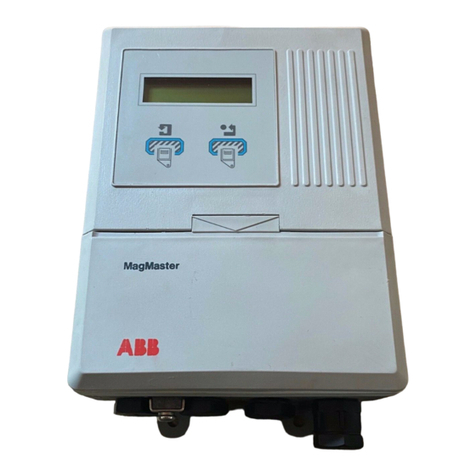
ABB
ABB MagMaster instruction manual
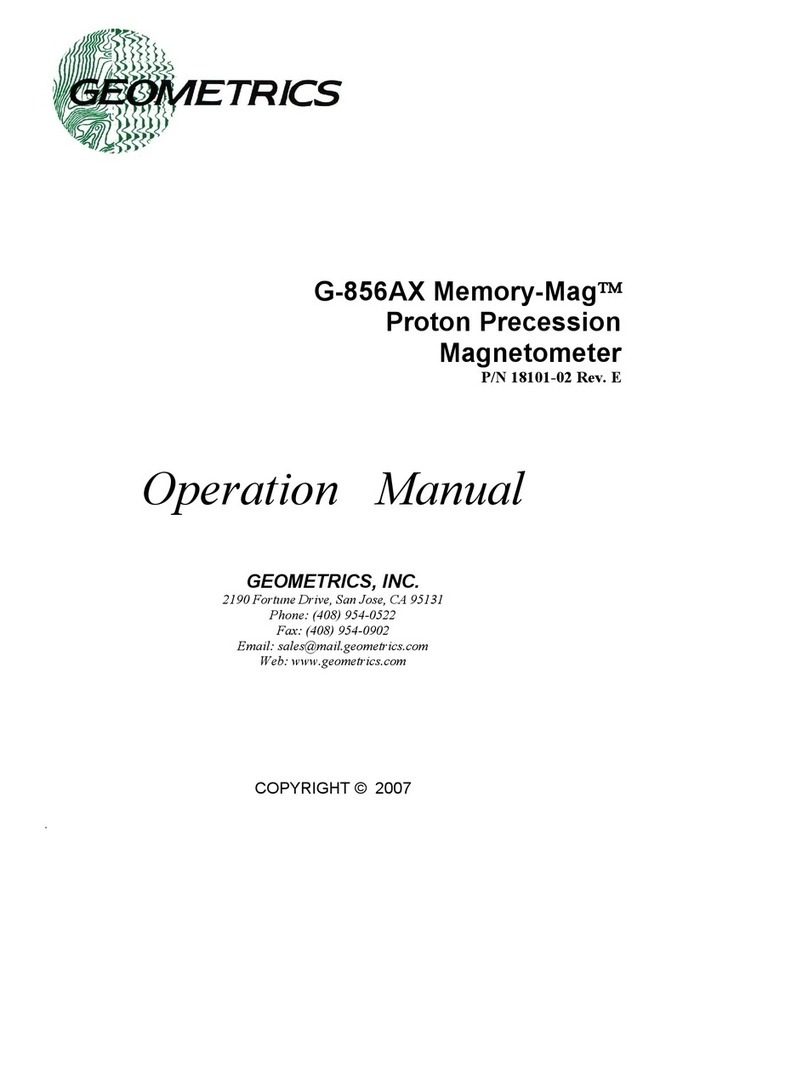
Geometrics
Geometrics Memory-Mag G-856AX Operation manual

Mirion Technologies
Mirion Technologies CheckPoint:Laundry RTM750 user manual
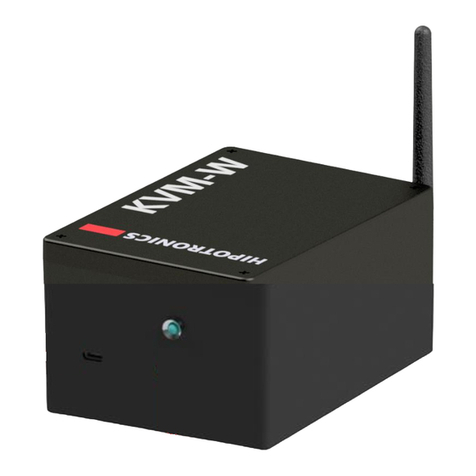
HIPOTRONICS
HIPOTRONICS KVM-W Series operating instructions
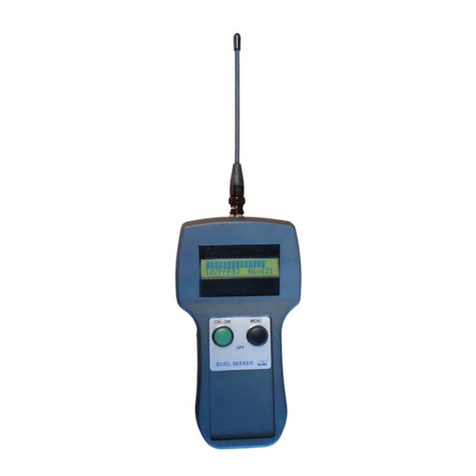
ELA
ELA Active RFid quick start
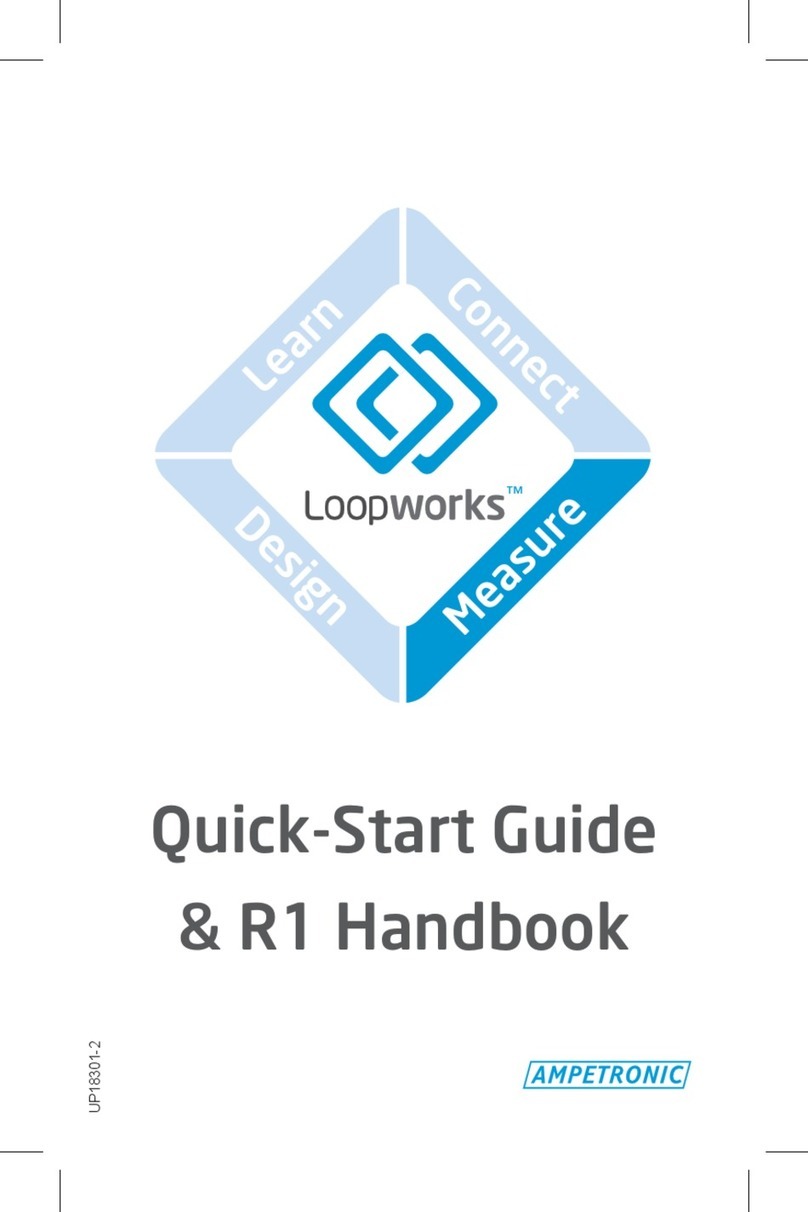
Ampetronic
Ampetronic Loopworks Measure R1 Quick-Start Guide & Handbook
